
The elfin woods warbler is a species of bird endemic to Puerto Rico, where it is local and uncommon. Discovered in 1968 and described in 1972, it is the most recently described New World warbler.
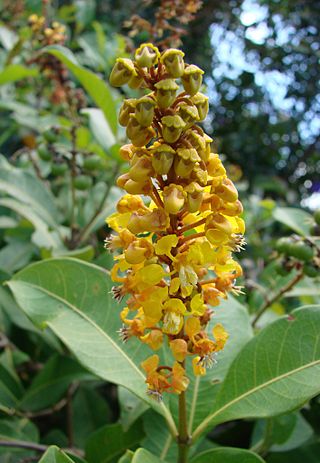
Byrsonima is one of about 75 genera in the Malpighiaceae, a family of flowering plants in the order Malpighiales. In particular in American English, they are known as locustberries. Another widely seen common name is serrets or serrettes.

Buxus vahlii, or Vahl's boxwood, is a rare species of plant in the boxwood family. It is native to Puerto Rico and St. Croix in the U.S. Virgin Islands, where it is known from no more than four populations total. It has probably never been very common, but its distribution has been reduced by deforestation and other human disturbance of its habitat. At the time it was listed as an endangered species of the United States in 1985, it was thought to be endemic to Puerto Rico. Reports that it existed in Jamaica have not been confirmed. A few individuals have been located in St. Croix, some of which are within Sandy Point National Wildlife Refuge.
Calycadenia pauciflora is a species of flowering plant in the family Asteraceae known by the common name smallflower western rosinweed. It is endemic to northern California, where it grows in the Coast Ranges north of the San Francisco Bay Area from Napa County to Tehama County, often on serpentine soils.
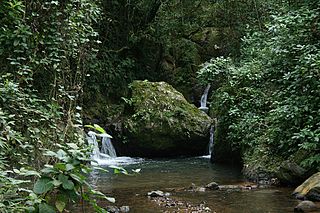
Maricao State Forest is a state forest located in the eastern Cordillera Central mountains of Puerto Rico. It is commonly known as Monte del Estado due to the fact that it was one of the first forest reserves in Puerto Rico to be designated a state forest in its official name. With an area of 10,803 acres (43.72 km2), the Maricao State Forest is the largest of the 20 forestry units of the Puerto Rico state forest system.

Catesbaea melanocarpa is a rare species of flowering plant in the coffee family known by the common name tropical lilythorn. It is native to five Caribbean islands: Puerto Rico, St. Croix in the United States Virgin Islands, Antigua, Barbuda, and one island in Guadeloupe. The plant is threatened by habitat loss.

Cornutia obovata is a rare species of tree in the mint family, and formerly considered a member of the verbena family. It is endemic to forested slopes in Puerto Rico, where its common names are capá jigüerilla, nigua, and palo de nigua. When it was added to the endangered species list of the United States in 1988 there were only seven individuals known to remain in the wild. By 1998 there were eight plants known. This is considered one population divided amongst a few locations in the mountain forests of the island.
Cranichis ricartii is a rare species of orchid known by the common name Puerto Rico helmet orchid. It is native to Puerto Rico, where it is known from three locations in one forest. The plant has also been seen in Guadeloupe. The plant's rarity is the main reason for its listing as an endangered species of the United States.
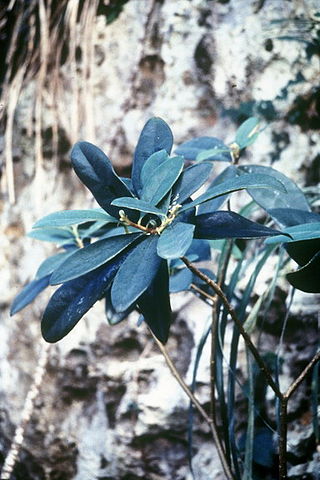
Daphnopsis hellerana is a rare species of flowering plant in the genus Daphnopsis of the family Thymelaeaceae. It is endemic to Puerto Rico, where there were only four populations remaining in 1992, with a total of 125 individuals. It was federally listed as an endangered species of the United States in 1988.

Mitracarpus maxwelliae is a rare species of flowering plant in the coffee family known by the common name Maxwell's girdlepod. It is endemic to Puerto Rico, where it is known only from the Guánica Commonwealth Forest in Guánica. It grows in only one location in a coastal scrub forest and dwarf forest with limestone gravel substrates. Other plants in the habitat include Bucida buceras, Bursera simaruba, Exostema caribaeum, Coccoloba microstachya, Plumeria alba, and Pilosocereus royenii.
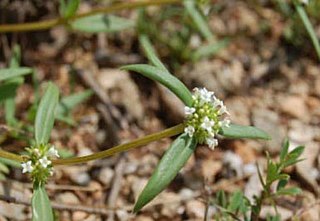
Mitracarpus polycladus is a rare species of flowering plant in the coffee family known by the common name cana gorda girdlepod. It is native to Puerto Rico, where it is known only to come from the Guánica Commonwealth Forest. It can also be found on the island of Saba. It grows in coastal scrub forest and dwarf forest with limestone gravel substrates. Other plants in the habitat include Bucida buceras, Bursera simaruba, Exostema caribaeum, Coccoloba microstachya, Plumeria alba, and Pilosocereus royenii.
Ottoschulzia rhodoxylon is a rare species of tree in the family Icacinaceae known by the common name pincho palo de rosa. It is native to Puerto Rico and Hispaniola. When it was listed as an endangered species under the United States' Endangered Species Act in 1990 there were only nine individuals remaining on Puerto Rico.

Peperomia wheeleri is a rare species of flowering plant in the pepper family known by the common name Wheeler's peperomia. It is endemic to Puerto Rico, where it is known only from the island of Culebra. It has become rare because of deforestation and grazing by livestock. It is a federally listed endangered species of the United States.

Vernonia proctorii is a rare species of flowering plant in the aster family known by the common name Proctor's ironweed. It is endemic to Puerto Rico, where there are two populations. It is threatened by the destruction of its habitat. It is a federally listed endangered species of the United States.

Brunfelsia densifolia is a species of flowering plant in the nightshade family known by the common name Serpentine Hill raintree. It is native to Puerto Rico.
Myrcia peduncularis is a species of flowering plant in the myrtle family known by the common names Maricao lidflower and serpentine lidflower. It is endemic to Puerto Rico, where it grows on serpentine soils at 300 to 400 meters in altitude, to a height of between 1.5 and 2 meters. There are perhaps 200 to 300 individuals left. Besides this, "there is nearly no information in the literature about this species."
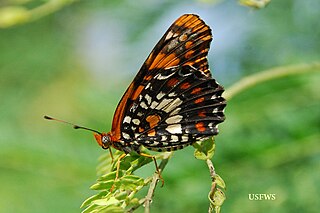
Atlantea tulita is a rare species of butterfly known by the common name Puerto Rico harlequin butterfly. This brush-footed butterfly is endemic to Puerto Rico. It is a candidate for United States federal protection as an endangered species. In 2011 a report found federal protection to be warranted, but it was precluded by other actions and it remains a candidate.

Magnolia portoricensis is a tree of the Caribbean region. Its vernacular names include jagüilla and Puerto Rico magnolia. It is native to Puerto Rico and it is found in the Toro Negro State Forest. It is an endangered tree and endemic to Puerto Rico. It is a dicot and a part of the family Magnoliaceae. It is an uncommon tree, found primarily in the central and western mountains at 500 to 925 m above sea level.

Valeriana pauciflora, commonly called the largeflower valerian, is a plant species in the Caprifoliaceae. It is native to the Eastern United States, where it is found in the regions of the Interior Low Plateau, the Ohio River drainage, and the Potomac River Valley. In this region, it is found in very nutrient-rich, mesic forest communities, often in stream valleys or lower slopes.

Varronia bellonis, commonly known as the serpentine manjack, is a species of flowering plant that was first reported in Susúa Puerto Rico in 1992, where a small group of five individuals was found. This endangered shrub is endemic to Puerto Rico. Due to habitat destruction, as of 1997, only 99 known plants remained in the wild, and the population of V. bellonis appeared to be in rapid decline. This discovery has spurred a reintroduction effort in Puerto Rico.

















